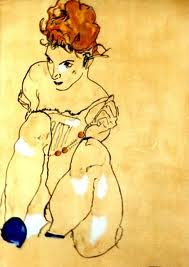In the 19th century divergent views of art were leading to different styles. The academies continued to teach drawing in a traditional way which was supported by Ingres amongst others. However there was a growing number of artists such as Courbet who thought that the schools were superfluous. By the end of the 19th century fresh ideas were developing as the modern era of photography and psychology brought new styles into the world of art. The Bauhaus was opened in 1919 in Germany which united art with design. The revolution in materials helped create new works and mark making became sufficient in itself as a reason for a work. In Vienna, Schiele, amongst others, was thrown out of the Academy for demanding reforms in teaching.
As Ingres supported the classical methods he could be said to follow a disciplined classical style or neo-classical style. This style is one that carries the idea that 'art imitates life'. The ateliers taught drawing by asking students to draw plaster casts of figures or sculptures until they reached a point when their skill was refined which entitled them to enter the life room.
However, there is no doubt when looking at Ingres' portraits, and there are over 400 extant, that we feel that we are looking at a true likeness of the sitter.
This drawing which I was fortunate enough to see this year at the Fitzwilliam Museum in Cambridge is in many ways similar in style to the one above. I was surprised when I saw it at how delicate it seemed in its execution. Ingres enjoyed using graphite on wove paper and often squared up his images for final execution. The detail of buttons on the right hand jacket is remarkable in its detail.
As these drawings show there is little difference in the way Ingres worked on the portraits which he supposedly disliked doing, but which earned him a living. I like the way the faces are the centre of interest and command our attention and note that this technique has been used by other artists such as is seen in the one below by Hockney.
margaret ken
Toulouse-Lautrec.
I've chosen Toulouse Lautrec as an artist whose work shows a more 'expressive' style. However, the line from Ingres through Degas to Lautrec in a way epitomises the way art styles were developing at this time. Degas very much admired the work of Ingres and followed his style under the guidance of Lamonthe at the Ecole des Beaux-Arts. As time passed Degas' subject matter changed and along with this so too did his techniques change. The colour of his palette gave way to brighter colours and the naturalistic style of former works became looser, with bolder strokes and more abstracted form. Degas used photography and would use this to capture the images of dancers for which he is renowned. It is in this respect that it could be argued that Lautrec followed Degas by becoming a painter of ordinary life.
'He wears my clothes, but cut down to his own size,' is a quote attributed to Degas about Lautrec. A somewhat cutting remark?
Lautrec's subject matter was modern life; the world of ordinary working people found in laundries, brothels and, of course, the dancers. And similarly to Degas, it's possible to see the influence of Japanese art on Lautrec.
This influence is shown by a lack of shadows and the diagonal split of the picture plane, both of which can be seen in the composition above. Lautrec's family were keen riders of horses and he grew up in an environment where horses were commonplace. Consequently many of his early works were of horses but it's the energy of the image that stands out in the depiction of the horse above. The exaggerated angle borrowed from the Japanese woodcuts can create a particularly expressive effect which Lautrec utilised to full advantage.
Yvette Guilbert
The subject of the above work was frequently drawn by Lautrec. The black gloves became a defining and stylised feature of his drawings of the singer. Whilst Guilbert initially disliked the images of her by Lautrec because they did not prettify her it is now considered that Lautrec captured the essence of his sitters in just a few strokes.
Photography provided an accurate or objective representation so it was the job of the artist to convey 'thought' and 'feeling'. Distortion and leaving pictures unfinished or loosely done could reproduce this 'truth' more than naturalism.
Being blighted by ill health and alcoholism it's thought that Lautrec was fascinated by the energy of dancers.
Chocolat Dancing in the Irish and American Bar
Indian ink, crayon watercolour on paper.
This drawing has been achieved with very few lines, very loosely drawn and most of the paper surface is showing through. It is not an attractive drawing in the conventional sense but it captures the elegance of Chocolat, the animation of the musician and the tedium of the barman. I like the way Lautrec is able to suggest emotion whether it's boredom, despair or debauchery. Also, I really like the colours used by him. The intensity of the nightclub scenes is shown in blues and blacks often with touches of orange hair. Whilst the faces of the clientele are stark white under the artificial light.
Looking at Lautrec's work encouraged me to look again at the work of Egon Schiele. His work is similarly loose and expressive. But in contrast to Lautrec,
Schiele's work is often harsh in it's emotional depictions. While Lautrec may not prettify his subjects he does show us them with more empathy which it's possible to see in the tender attitudes of pictures of women together in bed; quite often the prostitutes he so often painted.








No comments:
Post a Comment